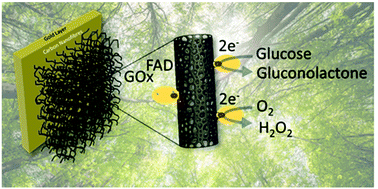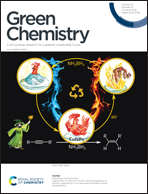Sustainable mesoporous carbon nanostructures derived from lignin for early detection of glucose†
Abstract
A third-generation glucose biosensor has been developed utilising glucose oxidase (GOx) immobilised on mesoporous carbon nanostructures. These nanostructures were produced from a 50% alcell lignin and 50% polylactic acid (PLA) precursor blend. Methylene diphenyl diisocyanate (MDI) has been incorporated to offset fusion during the thermal stabilisation phase. The PLA is sacrificial at higher carbonisation temperatures and this allows the controlled formation of a high 50% relative volume of mesopores (2–4 nm) within larger pores. The result is a hierarchical structure, ideal for GOx immobilisation, with an increased external area that allows for a high surface coverage of 3.0 × 10−10 mol cm−2 and fast direct electron transfer (DET) of 1.3 s−1 between the mesoporous carbon and the active redox groups of GOx. The immobilised enzyme exhibits strong, selective activity on glucose, with or without oxygen, attributed to its high affinity to the electrode, with a Michaelis–Menten constant Km of 0.600 mM. At optimum conditions, the biosensor exhibits a linear response between 0.15 and 2.7 mM, with a high sensitivity of 50 μA mM−1 cm−2 and a limit of detection (LoD) of 89 μmol L−1 for a signal to noise ratio of 3.



 Please wait while we load your content...
Please wait while we load your content...